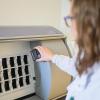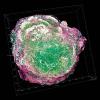Ageing, or senescent cells, which stop dividing but don’t die, can accumulate in the body over the years and fuel chronic inflammation that contributes to conditions such as cancer and degenerative disorders.

In mice, eliminating senescent cells from ageing tissues can restore tissue balance and lead to an increased healthy lifespan.
Now a team led by investigators at Massachusetts General Hospital (MGH), has found that the immune response to a virus that is ubiquitously present in human tissues can detect and eliminate senescent cells in the skin.
The scientists analysed young and old human skin samples to learn more about the clearance of senescent cells in human tissue.
They found more senescent cells in the old skin compared with young skin samples. However, in the samples from old individuals, the number of senescent cells did not increase as individuals got progressively older, suggesting that some type of mechanism kicks in to keep them in check.
Experiments suggested that once a person becomes elderly, certain immune cells called killer CD4+ T cells are responsible for keeping senescent cells from increasing. Higher numbers of killer CD4+ T cells in tissue samples were associated with reduced numbers of senescent cells in old skin.
When they assessed how killer CD4+ T cells keep senescent cells in check, the researchers found that ageing skin cells express a protein, or antigen, produced by human cytomegalovirus, a pervasive herpesvirus that establishes lifelong latent infection in most humans without any symptoms.
By expressing this protein, senescent cells become targets for attack by killer CD4+ T cells.
Image Credit | SPL




